U.S. Department of Transportation
Federal Highway Administration
1200 New Jersey Avenue, SE
Washington, DC 20590
202-366-4000
Federal Highway Administration Research and Technology
Coordinating, Developing, and Delivering Highway Transportation Innovations
| REPORT |
| This report is an archived publication and may contain dated technical, contact, and link information |
|
| Publication Number: FHWA-HRT-15-049 Date: April 2015 |
Publication Number: FHWA-HRT-15-049 Date: April 2015 |
 |
| © S.Dashkevych/Rawpixel/Shutterstock.com |
| Managing the LTPP program presents budgetary, administrative, and technical challenges, requiring the cooperation of 62 transportation agencies and involving the concerns of numerous stakeholders in the highway community. |
Ambitious objectives were set for the LTPP program from the start, whose achievement has been challenged by multiple internal and external factors including transitions between two management agencies and five highway legislations. The program’s success can be attributed to the support and investment of the participating highway agencies, the expertise of the advisory structure, and the tenacity and focus of management staff who guided and executed the program with the support of its professional contractors.
The LTPP program began operations in 1987 under the 5-year, $150 million, Strategic Highway Research Program (SHRP) administered by the National Research Council of the National Academy of Sciences. In 1991, the Federal Highway Administration (FHWA) made a commitment to assume LTPP management and administrative responsibilities when SHRP ended in 1992 to complete the pavement performance monitoring. From the program’s inception, it was understood that realizing the full benefit of this research investment would require the program to continue over the long term. Experience has shown that even periods upwards of 40 years are needed to better characterize the performance of some types of pavement structures.
It was also understood that for the LTPP program to meet its objectives, the individual experimental studies in the program had to be carefully designed to yield verifiable conclusions, and the massive data collection effort had to be uniform and consistent from study to study and from place to place. The data had to be stored and made readily accessible to all LTPP participants and future researchers. These conditions required a nationwide level of cooperation among highway agencies, researchers, contractors, and national organizations seldom seen in pavement research. SHRP and then FHWA managed and coordinated this multi-organizational effort with the cooperation of the highway agencies, advisory groups, and sister organizations, and with the assistance of contractors at the regional and national levels.
| Key Milestones in the Management of LTPP | |
|---|---|
| 1987 | SHRP 5-year program authorized and funded by Surface Transportation and Uniform Relocation Assistance Act |
| 1987 | SHRP awards Technical Assistance Contract |
| 1987 | SHRP establishes Pavement Performance Advisory Committee |
| 1987 | SHRP awards four Regional Coordination Office Contracts to begin in 1988 |
| 1991 | Transition to FHWA management of LTPP begins |
| 1991 | FHWA funding for LTPP continuation granted by Intermodal Surface Transportation Efficiency Act |
| 1992 | SHRP ends; FHWA assumes management of LTPP |
| 1992 | FHWA awards its first Technical Assistance Contract and Regional Coordination Office Contracts |
| 1993 | FHWA contracts with TRB for services of Pavement Performance Advisory Committee |
| 1995 | TRB establishes Long-Term Pavement Performance Committee |
| 2006 | Customer support functions transferred from contract to LTPP Team and General Administration Support Contract |
| 2006 | Six TRB LTPP ETGs merged into two |
| 2011 | First LTPP Webinar held |
| 2013 | Two TRB LTPP ETGs merged into one |
It was thought that data collection activities would be most effectively managed on a regional basis provided that adequate quality assurance (QA) programs were in place to ensure quality and consistency. Four regions were defined in the United States and Canada—North Atlantic, North Central, Southern, and Western—each with an office established and staffed by contracted firms with expertise in pavement performance monitoring. The LTPP regional offices served as collection and validation centers for pavement section data. In addition, a technical assistance contractor assisted SHRP and, later, FHWA management in overseeing the program. Figure 2.1 shows the four LTPP regions, their boundaries, and the locations of the LTPP offices.
This chapter describes the program’s management through national and regional contracts and staffing arrangements, first under SHRP (1987 to 1992), then under the transitional period when SHRP was ending (1991 to 1992), and finally under FHWA’s management (1992 through the present). During the latter period, funding levels under U.S. highway legislation have varied. Priorities and activities are often driven by the availability of funds, and reductions in Federal funding have had a major impact on the LTPP program. Additional management issues related to these changes in Federal funding are discussed in chapter 4. This chapter also discusses the various communication, coordination, and outreach practices followed by the LTPP program throughout the years.
The Surface Transportation and Uniform Relocation Assistance Act of 1987 authorized and provided funding to SHRP. That same year, under the sponsorship of the National Research Council, a SHRP program office was established in Washington, DC, continuing the pre-implementation work and contractual relationships that had been ongoing since 1984 for a long-term monitoring study (discussed in chapter 1). Of the six research areas proposed for SHRP, operations began in four: Asphalt Characteristics, Concrete and Structures, Highway Operations, and Long-Term Pavement Performance.1,2 (The proposed Snow and Ice Control and Maintenance Cost-Effectiveness research areas were combined in the Highway Operations area, which also addressed work zone safety. The proposed Concrete Bridge Component Protection and Cement and Concrete research areas were combined within the Concrete and Structures area.)
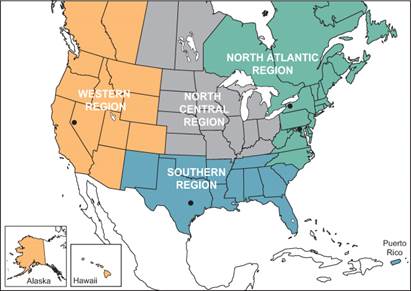 |
| Figure 2.1. The four LTPP regions and current regional offices (North Atlantic and North Central: Buffalo, NY; Southern: Austin, TX; Western: Reno, NV). In 2003, Buffalo, NY, became the regional office for both the North Atlantic and North Central regions. The office for the central technical support services contractor is also shown: Beltsville, MD. |
The SHRP executive director was responsible for overall program management, while four SHRP program managers were responsible for the daily operations in their respective focus areas with the support of a small staff of engineers and loaned staff, who played a major role in the program. Collectively, the SHRP executive director, program managers, and support staff represented the central management staff for the four SHRP program areas.
For the LTPP program area, a senior engineer, the SHRP-LTPP director, was responsible for all technical activities, and four other engineers in the SHRP central office were individually responsible for pavement monitoring activities, field sampling and materials testing activities, database operations, and traffic monitoring activities. The management structure is shown in figure 2.2.
In addition, four engineers contracted to SHRP served as extensions to the central LTPP management staff, each based at one of the four regional coordination offices. The SHRP regional engineers were responsible for overseeing and reporting on the regional contractors’activities to the central management staff in Washington, DC, as well as for providing overall support to the regional offices in a variety of activities including program marketing and test section recruitment. Specific activities carried out by regional engineers included the following:
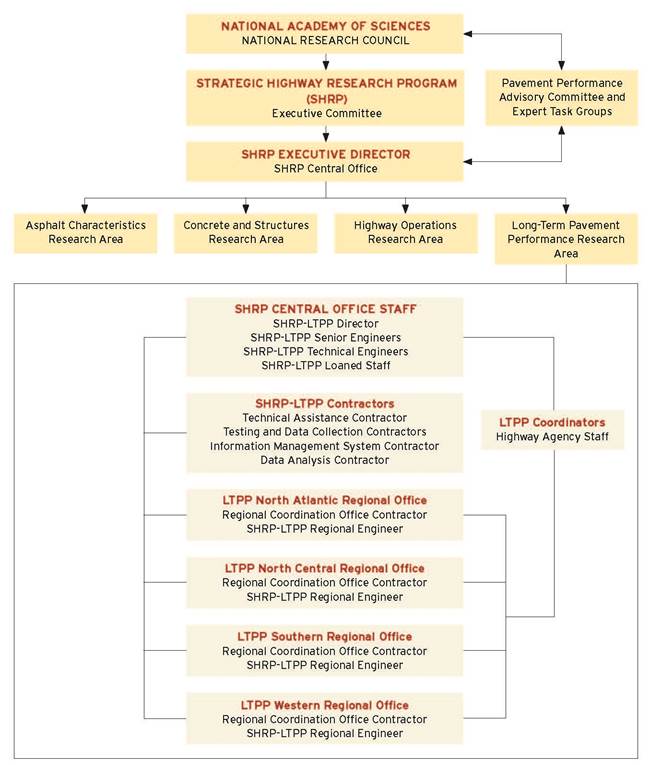 |
| Figure 2.2. Structure of the LTPP organization during the SHRP-LTPP years (1987–92). |
Additional staffing was provided to the LTPP program through the loaned staff program (see sidebar), which allowed employees of highway and transportation agencies (both national and international) to assist in program implementation while bringing their agencies’perspectives to program management at the national level. FHWA had staff on loan to SHRP from the program’s inception. For example, in May 1987, six of the 10 SHRP-LTPP staff were on loan: one from FHWA, one from Sweden, one from Canada, and three from highway agencies. Other professional experts who contributed to the LTPP program through the loaned staff program were university professors and researchers. In some cases, professors were on sabbatical while working with the LTPP program staff. When SHRP ended and FHWA assumed management, the practice continued. Nearly 100 individuals have participated in the LTPP program through these interagency loans, providing both practical support and an essential cross-fertilization of ideas to the program.
The P-001 LTPP Technical Assistance Contract, awarded in 1987, was the first contract under the LTPP program. The central LTPP management staff retained the services of this contractor to provide technical and management services in support of SHRP in the development and conduct of the LTPP studies. The contractor was referred to as the “technical assistance contractor” under SHRP. The activities provided by this contract included the following:
LOANED STAFF PROGRAM
The program allowed the loaned staff to broaden their technical expertise and interact with the pavement community at the national and international levels, while giving their agencies a voice in the direction of the program. Typically, loaned staffers tended to focus their efforts on specific technical activities such as traffic monitoring and seasonal monitoring. The LTPP program benefited as the team gained first-hand knowledge of the operations, perspectives, and priorities of highway agencies. This mutual arrangement benefited both the LTPP program and the highway agencies. |
After the Technical Assistance Contract was awarded in 1987, several additional contracts were awarded to advance full implementation of the LTPP program. Many of these were directly associated with the four LTPP regions.
Together with the LTPP Technical Assistance Contract, the four LTPP regional office contracts, implemented in 1988, represented the primary and largest (cost-wise) LTPP contracts (P-004, North Atlantic; P-005, Southern; P-006, North Central; and P-007, Western). The objective of the regional contracts was to provide technical and management services to SHRP in the collection of high-quality data and related activities in the development and conduct of the LTPP studies. The activities provided by these contractors included the following:
Other major LTPP contracts were awarded during the 1987 to 1992 SHRP era (appendix B) to perform the following activities at the LTPP test sections:
Although not of the financial magnitude of those listed above, a few other contracts were awarded during the SHRP-LTPP era. Examples include the development and implementation of FWD calibration centers, which became a major SHRP product, and the evaluation of ground-penetrating radar technology for use in layer thickness determinations at LTPP test sections.3 The Materials Reference Library was established under a SHRP contract and later transferred to the LTPP program.
During the SHRP-LTPP years, the Pavement Performance Advisory Committee (hereafter Advisory Committee) provided oversight and guidance for the LTPP program. This was the first of two volunteer committees of the National Research Council of the National Academy of Sciences to provide advice pertaining to the LTPP program, and it performed its function until 1995. The Advisory Committee provided programmatic review and technical commentary on the program objectives, long-range plans, near-term operational activities, and progress of the LTPP research program. It also conducted external, nongovernmental reviews of, and comments on, the technical progress of ongoing pavement performance research, and it identified needs for further research projects.
The committee was also required to provide assistance to FHWA in its selection and implementation of SHRP research products. Accordingly, some of its tasks included monitoring the SHRP implementation activities of FHWA and providing written critiques of specific technology transfer efforts related to SHRP products. The committee developed advice on alternative technology transfer techniques and other actions needed to ensure effective deployment of and technical support for SHRP research products.
Various subcommittees to the Advisory Committee, known as the Expert Task Groups or ETGs, addressed specific program technical issues. Members of the ETGs were experts in their respective research areas and were drawn from highway agencies, industry, academia, SHRP, and FHWA. Eight ETGs existed during the 1987 to 1992 SHRP period of the LTPP program:
The membership and scope of the ETGs are described in appendix A.
In 1991, as SHRP was approaching the completion of its mandate, a task force composed of high-level decision makers from the American Association of State Highway and Transportation Officials (AASHTO), FHWA, SHRP, and the Transportation Research Board (TRB) was assembled to evaluate and recommend the best approach for a seamless transition of the LTPP program from SHRP to a new management organization.
The consensus of this task force was to recommend FHWA as the rational option for assuming management of the LTPP program in 1992 and seeing it through to its conclusion. FHWA was recommended for three reasons:
The task force established a transition period of December 18, 1991 (date on which the Intermodal Surface Transportation Efficiency Act or ISTEA was enacted) to June 30, 1992. Transition activities during that 6-month period included the following:
The last Pavement Performance Advisory Committee meeting under SHRP took place during the week of April 6, 1992, and the last SHRP Executive Committee meeting took place June 2–3, 1992. The seamless transition of LTPP program management and operation activities from SHRP to FHWA was completed on June 30, 1992, and FHWA began administrating the program on July 1, 1992. Figure 2.3 shows the SHRP-LTPP and FHWA-LTPP staff members who served during the program transition.
It should be noted that FHWA also took over the responsibility of carrying on the activities and implementing the results and findings from the other three major SHRP research areas—Asphalt, Concrete, and Highway Operations. In addition, FHWA took over management of the Materials Reference Library established under the SHRP Asphalt research area, which over time would become an important repository of LTPP materials samples and 35-mm distress film as well as the repository of materials samples from other important national research studies.
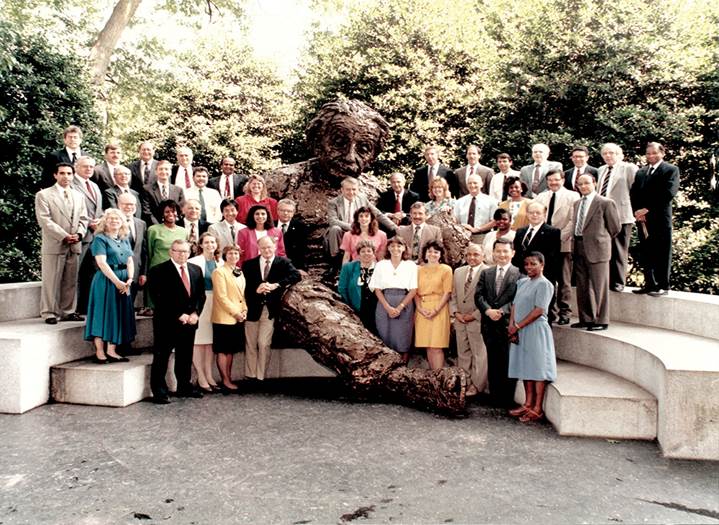 |
| FIGURE 2.3. SHRP-LTPP and FHWA-LTPP staff members during the LTPP program transition. Front Row (left to right): Cal Berge, Cheryl Richter, Rita Leahy, Neil Hawks, Brenda Buchbinder, Margie Sheriff, Karen Smith, Kris Gupta, Paul Teng, Vondell Little. Second Row: Marsha Barrett, Guy Hager, Cindy Baker, Monte Symons, Keizo Kamiya, Juliet Narsiah, Marty Laylor, Cindy Johnson, Harry Jones, David Esch, Carliss Parker-Smith, Homer Wheeler. Third Row: Shahed Rowshan, Ivan Pecnik, Joe Lamond, Bill Carr, Bob Kelley, Kathy Brosseau, Don Harriott, Stella White, Ray Torrey, Lisa McNeil, Harold Von Quintus, Amir Hanna. Back Row: Aramis López, Bill Bellinger, Dick Ingberg, Brian Cox, Shashikant Shah, Damian Kulash, Jack Youtcheff, Radu Andrei, John Hibbs, Robert Raab, Ed Harrigan, K. T. Thirumalai. |
Enacted December 18, 1991, ISTEA authorized continuation of the LTPP program and implementation of SHRP products under FHWA management (see sidebar). ISTEA also provided FHWA funding to support these activities. FHWA established the LTPP program office at FHWA’s Turner-Fairbank Highway Research Center (hereafter, the FHWA highway research center) in McLean, Virginia.
The FHWA organizational structure has changed a number of times since the LTPP program began; however, the 2012 structure presented in figure 2.4 fairly represents the LTPP program’s functioning within FHWA. The LTPP Team falls under FHWA’s Office of Infrastructure Research and Development. Figure 2.5 shows the organization of the FHWA-LTPP program.
The FHWA-LTPP team leader is responsible for overall program management and daily operations of the LTPP program. In addition to the team leader, the central FHWA-LTPP management staff includes these members:
TRANSITION OF LTPP PROGRAM FROM SHRP TO FHWA
|
The pavement performance monitoring activities as well as other LTPP functions not listed above, such as management of data collection equipment, product development, and customer support services, have been distributed among the team members based on their experience and the team’s needs. While there have been some functional changes of responsibilities, the structure of the LTPP Team has been consistent over the years.
Between 1992 and 2002, the FHWA-LTPP central management staff also depended on the services of four FHWA engineers who were based at the LTPP regional coordination offices (although they are not shown in figure 2.5). These engineers performed the same functions assigned to the SHRP-LTPP regional engineers during the SHRP 1987 to 1992 period.
Like the SHRP managers, the FHWA-LTPP Team has also counted on the support of loaned staff from State, Provincial, and international highway agencies, especially during the 1990s. These individuals typically have rotated on a 1- to 2-year basis and have tended to focus their efforts on specific technical activities such as deflection testing, traffic data collection, and the Seasonal Monitoring Program.
The States and Provinces continue to make significant contributions to the LTPP program under FHWA’s management, as they did during the SHRP years. The highway agencies provide test section construction, materials testing, traffic control and other data collection management support, staff, and equipment required for the broad array of LTPP activities. In addition, groups of States have entered into pooled-fund agreements in support of several important LTPP activities for which no other financial support was available.
The first FHWA-LTPP Technical Assistance Contract was awarded by FHWA in July 1992 to provide all necessary facilities, equipment, services, supplies, materials, and personnel to perform pavement engineering, traffic engineering, and IMS technical activities in support of the FHWA-LTPP program. Specific activities required under this contract have included the following:
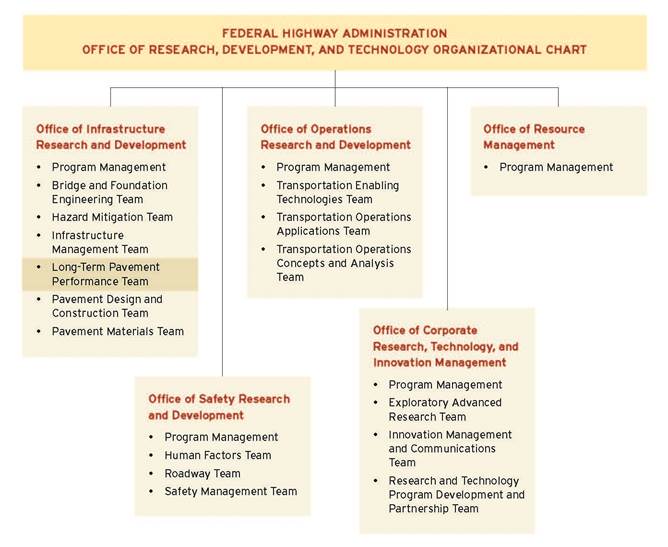 |
| Figure 2.4. LTPP within the FHWA Turner-Fairbank Highway Research Center organizational structure (2012). |
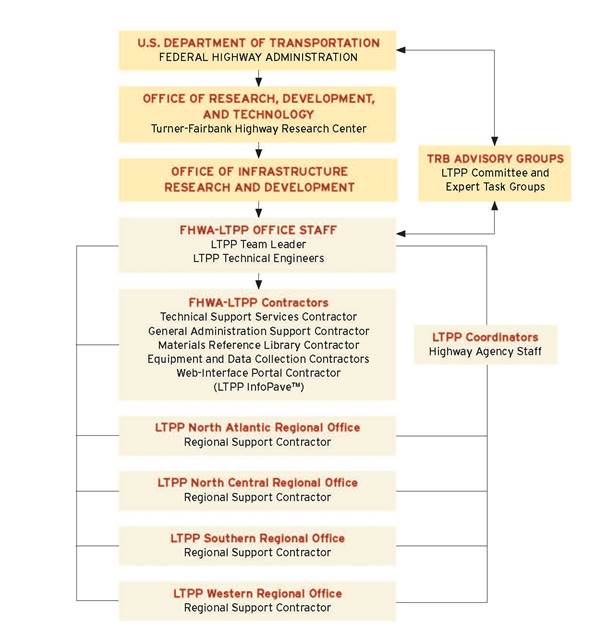 |
| FIGURE 2.5. General structure of the LTPP organization during the FHWA-LTPP years (1992–present). |
The 1992 LTPP Technical Assistance Contract was in place until 1997. It was re-advertised and awarded by FHWA in 1997, 2002, and 2009. The name of the contract changed to LTPP Technical Support Services Contract or TSSC in 1997 and remains as such today. Other historical facts with regard to the objectives for the LTPP Technical Assistance and Technical Support Services contracts include the following:
The first regional office contracts under FHWA management were issued in May 1992 for a 4-year period during the transition of the LTPP program from SHRP to FHWA. As the contracts were ending, they were re-advertised and awarded for additional 5-year periods in 1996, 2001, 2006, and 2011 (appendix B).
The objective of the LTPP regional contracts is to provide technical services in support of the development and conduct of LTPP studies, including all data collection, data processing, and data quality activities for LTPP project sections within each region’s geographical boundaries, as previously defined under SHRP. Not only are the regional contractors responsible for day-to-day operations and maintaining a high level of data quality, but they play an important part in sustaining the program through their active coordination with the highway agencies. Specific activities that have been required under these contracts are listed below:
As SHRP had done earlier, FHWA has awarded other major LTPP contracts (appendix B) to perform the following activities:
In addition, other contracts have been awarded by FHWA to further meet the goal and objectives of the LTPP program. These contracts provided or are providing the following services:
More information for each of these contracts is discussed in appendix B.
As noted earlier, FHWA entered into a contract with SHRP to continue to provide the peer-review functions of the LTPP Pavement Performance Advisory Committee and its supporting ETGs for a 15-month period ending September 20, 1993. Subsequently, the FHWA entered into a direct contract with TRB to provide formal peer review regarding LTPP program matters. This contract has been renewed throughout the life of the LTPP program.
Once SHRP ended in 1992, the Pavement Performance Advisory Committee provided its counsel to FHWA and AASHTO until 1995, when the committee was retired. The TRB Long-Term Pavement Performance Committee (LCOM) was then established to provide advice on LTPP’s program planning and operations, review progress, and coordinate work conducted by various ETG subcommittees on specific technical issues. Thus, LCOM became the second of two committees of the National Research Council to provide advice pertaining to the LTPP studies. The charge to LCOM by TRB is as follows:
This committee, acting through the National Research Council, will advise the Federal Highway Administration (FHWA) and the American Association of State Highway and Transportation Officials (AASHTO) on the planning and execution of the Long-Term Pavement Performance (LTPP) studies. The LTPP studies are a set of operational activities consisting of compiling and analyzing data that is being collected on more than 2,500 in-service pavements in the United States and Canada. The principal objective of this data collection and analysis is to further the understanding of how and why pavements deteriorate when subjected to traffic loadings and environmental conditions. Data collection and analysis began in 1987 and will continue beyond 2013 for a substantial number of test sections that are still providing valuable data. The program is also adding test sections to investigate the performance of warm-mix asphalt and other pavement topics. The committee will prepare reports, including letter reports, containing the committee’s evaluations and suggested mechanisms to enhance the utility to the states of the studies’outcomes.6
This charge is in line with the objective established under FHWA’s contract with TRB, which is to continue to conduct and document a program to assist in the guidance of current and future activities related to the conduct and operation of LTPP data collection, analysis, product development, delivery, coordination, evaluation, and communication activities. Furthermore, the contract stipulates that accomplishing this objective is the responsibility of LCOM. This group convenes twice a year to develop and provide strategic recommendations that assist in the guidance of current and future activities related to the conduct and operation of the LTPP program (figure 2.6). These recommendations are sent in the form of a letter report to the FHWA Administrator and AASHTO Executive Director after each meeting.
As was the case with the TRB Pavement Performance Advisory Committee, various subcommittees or ETGs were formed to address specific program technical issues in support of LCOM. These groups enlisted experts from highway agencies, industry, academia, and FHWA. Through 2006, five ETGs provided support to LCOM:
The scope and membership of the ETGs are described in appendix A.
In addition to these ETGs, two subcommittees served LCOM. The Subcommittee for Product Development and Delivery was established in 1999 to define a future course for the LTPP program to maximize its outcomes and products (chapter 10).7 The Program Improvement Subcommittee, composed of selected members from LCOM, was established in 1997 to review and oversee FHWA’s implementation of the results of the 1996 Program Assessment—a formal evaluation of the program’s achievements in relation to its goal, objectives, and future direction.8 Activities identified as a result of that assessment, which became part of the subcommittee’s purview, included the following:
This subcommittee ended in 1999, when the program improvements were well underway.
In 2006, as a direct result of the budget constraints imposed on the LTPP program by the 2005 highway legislation (Safe, Accountable, Flexible, Efficient Transportation Equity Act: A Legacy for Users), the number of ETGs providing support to LCOM was reduced to two. The TRB ETG on LTPP Traffic Data Collection and Analysis was continued, and a multipurpose TRB ETG on LTPP Special Activities was created that assumed many of the technical functions of the ETGs that were discontinued.
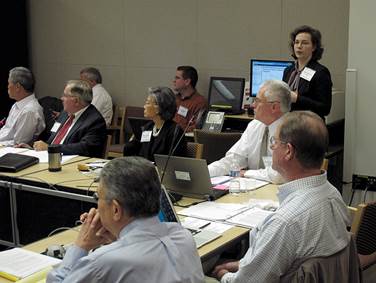 © The Transportation Research Board, www.trb.org |
| FIGURE 2.6. LTPP Committee meeting held in Washington, DC, on October 29, 2013. Left to right, clockwise: Randy Iwasaki (Contra Costa Transportation Authority), Gary Hoffman (Pennsylvania Asphalt Pavement Association), Jorge Pagán-Ortiz (FHWA), Pat Hu (Office of Secretary of Transportation), Larry Wiser (LTPP Program), Aramis López (LTPP Program), Olga Selezneva (Applied Research Associates, Inc.), William Temple, Chair (Concrete and Aggregates Association of Louisiana), and Robert Raab (TRB). |
Between 2006 and 2013, LCOM, with the support of the Traffic Data Collection and Analysis and Special Activities ETGs, provided the formal peer review functions for all LTPP-related activities. In 2013, the Traffic ETG was retired, and its functions were assigned to the Special Activities ETG.
The LTPP program’s longevity and success is due to the open dialogue and constant feedback that has been in practice since the SHRP years. The planners of the program had the foresight to know that clear communication and a well-coordinated effort with many people and organizations would be required to achieve the goal and objectives of such a detailed and grand research program. The communication and coordination practices of the LTPP program have distributed important information about the program, and allowed a feedback mechanism for the program’s stakeholders, partners, and data users to share their input to improve the research being conducted.
Disseminating information to stakeholders has been a high priority for the LTPP program. The program has used different communication mechanisms throughout the years, from holding national meetings and workshops, to meeting with individual highway agencies, to participating in agency-sponsored LTPP meetings. In addition, reports, articles, newsletters, and other publications have been made available. The methods used to communicate with LTPP stakeholders have changed over the years with changes in technology and resources.
Meetings
Communicating the benefits of the LTPP program and listening to stakeholder input concerning its plans and progress have been of paramount importance to SHRP and FHWA. A key piece of this communication has involved participating in national and regional conferences over the years. Highlights include many different events at the annual TRB meetings in Washington, DC, such as the LTPP State Coordinators’Meeting, International Coordinators’Meeting, LTPP Technical Session, and presentations during other technical sessions. The LTPP sessions held each year during the TRB annual meeting discuss different topics relating to the program and often feature presentations from a highway agency perspective or from a university that has used LTPP data in its curriculum.In addition to participating in the TRB annual meeting, the LTPP program has held national meetings through the years with stakeholders to discuss data collection and monitoring issues and provide an update on the program’s progress and plans. These national meetings include the Colorado Mid-Course Assessment Meeting in 1990, California LTPP National Meeting in 1996, Rhode Island LTPP Specific Pavement Study Workshop in 2000, LTPP Pavement Analysis Forum in 2010, and many others. The LTPP program has also been represented in many AASHTO meetings, including those of the Standing Committee on Research, Research Advisory Committee, and Subcommittee on Materials.
Coordination meetings have been held with individual highway agencies since the program began. The LTPP program staff and its contractors often meet with representatives of State and Provincial agencies and FHWA Division Offices, for example, to discuss data collection, equipment installation, and traffic control issues, as well as other LTPP-related issues specific to the highway agency. In the early years of the program, these coordination meetings focused on recruitment and nomination of LTPP test sections. In the last several years, the agency visits have focused on plans to establish two new SPS experiments (warm-mix asphalt and pavement preservation).
The LTPP regional support contractors held meetings for many years to bring together the LTPP Coordinators from the highway agencies within their respective regions to discuss progress within their agencies and to hear presentations on big-picture items within the LTPP program. These meetings were phased out in the early 2000s as program funds became more limited and out-of-state travel became more difficult for highway agency personnel. Later, the LTPP program began to hold face-to-face meetings at State/Provincial highway agency offices with agency staff, regional contractors, and LTPP program staff. Figure 2.7 shows a meeting held in 2011 with the Connecticut Department of Transportation.
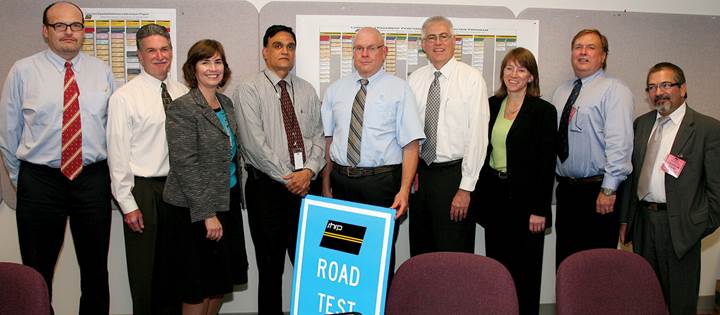 |
| FIGURE 2.7. Connecticut Department of Transportation (CT DOT) staff meet with the LTPP program and regional support contractor staff. Pictured from left to right: Edgardo Block, Thomas Harley, Anne-Marie McDonnell (LTPP State Coordinator), Ravi Chandran (CT DOT); Frank Meyer (LTPP North Atlantic Region); Aramis López (LTPP Program); Amy Jackson-Grove (Connecticut FHWA Division Office); Jack Springer (LTPP Program); and Basel Abukhater (LTPP North Atlantic Region). |
HIGHWAY AGENCY COORDINATORS’ MEETINGSAchieving Real Results on Real Roads
|
LTPP meetings held by the highway agencies have helped to sustain agency commitment to the program. The meetings have kept agency staff informed and encouraged fruitful exchanges between agency staff and the program. For example, in the State of Texas, each district office met every 12 to 18 months with someone from the LTPP program staff, regional support contractors, and other contractors to learn more about the program and why it is important at the State and national levels (see sidebar). Because the meetings kept the State’s field staff informed about the test sections in their respective districts, the staff understood why it is necessary to monitor the test sections until the end of their design life, without jeopardizing the safety of the driving public. State efforts like the Texas meetings possibly allowed many LTPP test sections to remain in the program for continued monitoring longer than they otherwise would have.
LTPP team members also participate in a variety of other national meetings, including the annual North American Travel Monitoring Exhibition and Conference, TRB’s biannual Data Analysis Working Group, and the annual Road Profiler User Group and Falling Weight Deflectometer User Group meetings. The participation of team members in these meetings allows them to collaborate with others on technical issues, keeping the program abreast of the latest in data collection and information technologies, and to offer face-to-face assistance to highway agencies.
The LTPP Web site and, in more recent years, Web conferencing technology have enabled a much larger number of people to participate in direct learning about the program and database and to do so with more frequency than face-to-face conferences would allow. The technology also enables the LTPP Team to benefit from a broader range of stakeholder feedback about the program and its products and a wider collaborative network as the program moves into the future. The first LTPP Webinar was held in September 2011 to give an overview of the program (see sidebar). Recorded Webinars are available on the LTPP Web site.
Publications
Special reports, brochures, exhibits, and various print and Web documents have been used to relay program information to wider audiences. Examples of reports include:
In addition, the program has published articles in highway publications, such as Focus, TRB’s TR News, Research & Technology Transporter, Roads & Bridges, Public Roads, and EDC News to present important pavement engineering issues to the broader community. The LTPP Web pages bring LTPP research and products directly to data users and also serve as an archive for program activities. The Web pages carry the LTPP Newsletter,18 communicating directly with stakeholders, the Year in Review articles that summarize activities and progress in the program, Key Findings reports that summarize LTPP data analysis projects,19,20 and hundreds of research reports that provide the findings from different studies.
While the success of the LTPP program is largely attributable to the partnerships that exist between the program and the highway engineering community, internal communication between the LTPP program staff and its supporting contractors has also played a vitally important role in the program’s achievements. LTPP management holds regular team meetings and teleconferences to maintain clear communication and coordinate program activities with the FHWA-LTPP staff and contractors both onsite at FHWA’s highway research center and offsite. These activities include a weekly staff meeting attended by FHWA-LTPP Team members, onsite contractors, and key offsite contractors, as well as personnel from other FHWA offices on occasion. Meetings feature briefings on the progress of program activities, discussion of pending and future issues, and planning and review of future LTPP Newsletter articles and Webinars.
COMMUNICATING WITH LTPP STAKEHOLDERS VIA THE WEBThe first LTPP Webinar was held September 2011 to provide more direct contact and interaction between the LTPP Team and program stakeholders. The team conducts informational Webinars, usually bimonthly, that are open to highway agencies, pavement industries, contractors, vendors, university professors and students, consultants, metropolitan planning organizations, and others with an interest in the program. Topics range from the general (future plans, program updates) to the very specific (demonstration of the dynamic modulus software, how traffic data are used) and include LTPP products and case studies.
|
As the LTPP technical support services contractor and the regional support contractors are primarily responsible for the program’s data collection and processing, data QC/QA, equipment maintenance, and other field activities, it has been particularly important to hold regular meetings with them to ensure consistency in various procedures and technical issues throughout the four LTPP regions. The FHWA-LTPP staff holds a 2-day formal meeting twice a year with the program’s core contractors to discuss many of the program’s large-scope issues and identify actions to resolve these issues (figure 2.8). Earlier in the program, these meetings were held quarterly. Another critical and very important communication tool used to ensure consistency among the LTPP regions is the use of program directives. Directives provide written instructions to the regions for collecting, processing, and managing LTPP data, equipment, and software.
In addition, the FHWA-LTPP staff holds routine meetings and teleconferences with the technical and regional support contractors to discuss issues specific to various program areas, such as distress, deflection, profile, traffic, automated weather stations, the Seasonal Monitoring Program, and the IMS. Targeted meetings and teleconferences are also held to discuss special projects. In the past, these have included projects such as the Materials Action Plan, the database, and forensic studies, as well as FHWA pooled-fund studies that involve the LTPP program.
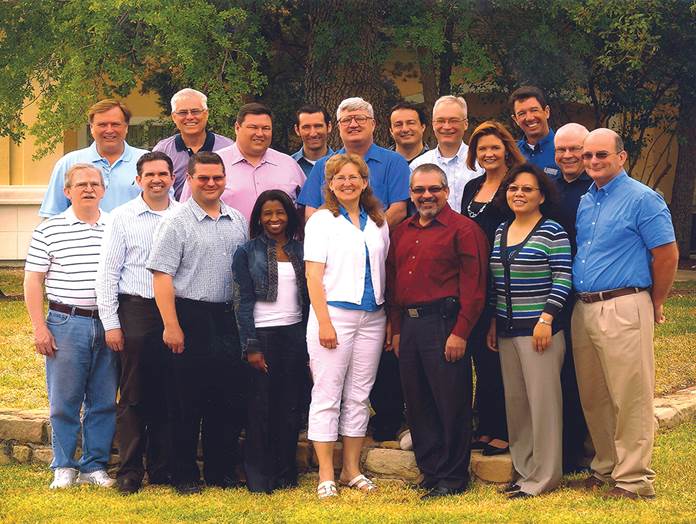 |
| Figure 2.8. LTPP program staff and core contractors meet to discuss the status of different program activities including data collection, database management and development, and future plans of the program. Front Row (left to right): William Bellinger, Kevin Senn, Larry Wiser, Deborah Walker, Miriam Pitz, Basel Abukhater, Jane Jiang, Jerry Daleiden. Second Row: Jack Springer, Tommy Clark, Gary Elkins, Sarah Tarpgaard, Frank Meyer. Third Row: Aramis López, Jason Puccinelli, Gabe Cimini, Jonathan Groeger, Mark Gardner (2011 in Austin, Texas). |
Managing the LTPP program presents a number of challenges—budgetary, administrative, and technical. The program spans two countries, requires the cooperation of 62 transportation agencies, and involves the concerns of numerous stakeholders within the highway community. Implementation challenges have been met with the expert advice and support of professional groups, industry organizations, and research institutions through the National Research Council advisory committees and related expert task groups. A significant management challenge arose when SHRP ended in 1992 and the objectives of long-term pavement performance monitoring had not yet been fulfilled. FHWA’s commitment to the program and assumption of its management enabled it to continue, and the management transition from SHRP to FHWA in 1992 was carefully planned and smoothly executed.
Throughout the program, a rigorous emphasis on quality has been maintained. To achieve a consistently high level of data quality across the program required planning and coordinating the activities of the many technical contractors who have served the program in various capacities, and addressing the concerns of the highway agencies. Consistent and constant communication and coordination with stakeholders and within the program are vital to meeting the program’s objectives.
As the program grew, management had to adapt to rapid technological changes in pavement monitoring and data management while also facing painful reductions in Federal funding (discussed in chapter 4) that have jeopardized the program’s completion. Nonetheless, the program has weathered these difficulties with the wisdom and guidance of the program managers, who are introduced in the following pages, and the support and commitment of its partners, whose contributions are acknowledged in chapter 3. On this solid foundation, the LTPP program is prepared to address the pavement research needs and technologies of the future.
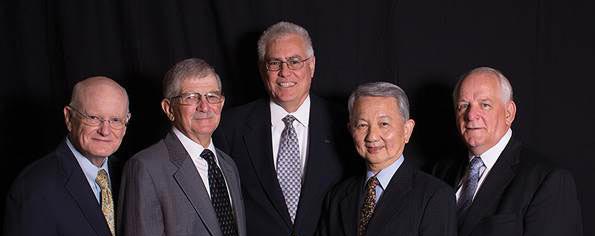
NEIL F. HAWKS
SHRP-LTPP Program Manager,
1987–1992
 Neil Hawks, P.E., recently retired from the Transportation Research Board (TRB) of the National Academies, where he was the Director of the second Strategic Highway Research Program (SHRP 2). SHRP 2 was a concentrated, focused program seeking to make strategic advances that will improve the safety, planning, travel-time reliability, and renewal of America’s highway system.
Neil Hawks, P.E., recently retired from the Transportation Research Board (TRB) of the National Academies, where he was the Director of the second Strategic Highway Research Program (SHRP 2). SHRP 2 was a concentrated, focused program seeking to make strategic advances that will improve the safety, planning, travel-time reliability, and renewal of America’s highway system.
Mr. Hawks joined the staff of the National Academies in 1982. From 1982 to 1987, he was the TRB Engineer of Soils, Geology and Foundations. From 1987 through 1992, Mr. Hawks was with the first Strategic Highway Research Program. At SHRP, he directed the Long-Term Pavement Performance Program and initiated the SHRP Asphalt Research Program. In 1992, he rejoined TRB as the Director of Special Programs. In this role, he provided direction to the five TRB Innovations Deserving Exploratory Analysis (IDEA) programs and to committees advising on the conduct of research and technology implementation.
Prior to joining TRB, Mr. Hawks worked for the Pennsylvania Department of Transportation for 14 years in geotechnical engineering, highway design, and construction.
He is a graduate of Columbia University and a registered professional engineer.
T. PAUL TENG
LTPP Division Director,
1991–1995
 Paul Teng, P. E., started his highway engineering career conducting paving materials research while pursuing a graduate degree at the University of Mississippi in 1964. Prior to joining the Federal Highway Administration (FHWA) in 1981, he held a range of engineering positions with the Mississippi State Highway Department, where he was the Department’s Research and Development Division Engineer from 1974 to 1981.
Paul Teng, P. E., started his highway engineering career conducting paving materials research while pursuing a graduate degree at the University of Mississippi in 1964. Prior to joining the Federal Highway Administration (FHWA) in 1981, he held a range of engineering positions with the Mississippi State Highway Department, where he was the Department’s Research and Development Division Engineer from 1974 to 1981.
At FHWA, Mr. Teng was assigned to a number of engineering, operations, and research and development positions and worked with industries, universities, trade associations, State highway agencies, and FHWA Division Offices on pavement engineering, rehabilitation, and management practices. In 1991, he established the Long-Term Pavement Performance Division, and was responsible for the transition of SHRP activities from the National Research Council to FHWA in 1992. He was selected into the U.S. Senior Executive Service and appointed as FHWA’s Chief Pavement Engineer in 1994. In 1999, Mr. Teng became Director, Office of Infrastructure Research and Development.
He has received numerous commendations and awards including the FHWA Administrator’s Award for Superior Achievement and the Secretary of Transportation’s Meritorious Achievement Award. As a professional engineer, Mr. Teng has authored many authoritative technical publications in the highway pavement and materials areas. He retired from FHWA in 2005.
CHARLES J. CHURILLA
LTPP Team Leader,
1995–1999
 Charles Churilla, P.E., has had a professional career of more than 40 years in the materials, geotechnical, and pavement engineering disciplines. During those years he worked for the Pennsylvania Department of Transportation, Federal Highway Administration (FHWA), and as a Principal Engineer for Applied Research Associates, Inc. He was the lead in the development of the FHWA Highways for LIFE concept and saw it through to fruition. He also led the FHWA Infrastructure Team in the development of the first-ever Infrastructure Research and Technology Plan. Mr. Churilla led the Long-Term Pavement Performance (LTPP) program from 1995 to 1999. Working with other FHWA headquarters and field offices he was instrumental in beginning the development and delivery of the LTPP technical products. He was responsible for the development and implementation of FHWA’s Full Scale Accelerated Testing Program using the ALF (accelerated loading facility) pavement testing machine.
Charles Churilla, P.E., has had a professional career of more than 40 years in the materials, geotechnical, and pavement engineering disciplines. During those years he worked for the Pennsylvania Department of Transportation, Federal Highway Administration (FHWA), and as a Principal Engineer for Applied Research Associates, Inc. He was the lead in the development of the FHWA Highways for LIFE concept and saw it through to fruition. He also led the FHWA Infrastructure Team in the development of the first-ever Infrastructure Research and Technology Plan. Mr. Churilla led the Long-Term Pavement Performance (LTPP) program from 1995 to 1999. Working with other FHWA headquarters and field offices he was instrumental in beginning the development and delivery of the LTPP technical products. He was responsible for the development and implementation of FHWA’s Full Scale Accelerated Testing Program using the ALF (accelerated loading facility) pavement testing machine.
Mr. Churilla was a member of the National Academy of Sciences, the American Association of State Highway Transportation Officials, and the Transportation Research Board. He is a registered professional engineer and an Honorary Member of Chi Epsilon, a civil engineering fraternity.
MONTE SYMONS
LTPP Team Leader,
1999–2001
 Monte Symons, P.E., received his B.S. and M.S. degrees in Civil Engineering from the University of Illinois and joined the Federal Highway Administration (FHWA) in 1975. In his career with FHWA, Mr. Symons served as Geotechnical Engineer in the Federal Lands Highway Program, Materials and Research Advisor to the Kuwait Ministry of Public Works Motorway System, Regional Pavement and Materials Engineer in Region 5, Team Leader for the Long-Term Pavement Performance research program, and Team Leader of the Infrastructure Team in the Midwest Resource Center. He finished his FHWA career as Team Leader for the National Pavement and Materials Resource Center Team.
Monte Symons, P.E., received his B.S. and M.S. degrees in Civil Engineering from the University of Illinois and joined the Federal Highway Administration (FHWA) in 1975. In his career with FHWA, Mr. Symons served as Geotechnical Engineer in the Federal Lands Highway Program, Materials and Research Advisor to the Kuwait Ministry of Public Works Motorway System, Regional Pavement and Materials Engineer in Region 5, Team Leader for the Long-Term Pavement Performance research program, and Team Leader of the Infrastructure Team in the Midwest Resource Center. He finished his FHWA career as Team Leader for the National Pavement and Materials Resource Center Team.
Mr. Symons’accomplishments included completing over 200 reports on pavement condition and design as well as subsurface reports for landslides and bridge foundations; developing and implementing the initial roadway inventory program for the U.S. National Park Service; assisting State highway agencies with pavement and materials issues; directing research programs to improve pavement performance and design life; and leading efforts to implement the latest pavement technologies.
After retiring from FHWA in 2005, he joined Auburn University as Director of the Airport Asphalt Pavement Technology Program, a 5-year, $4.8 million effort that completed 19 projects. He is currently the CEO of Montista Consulting LLC.
ARAMIS LÓPEZ
LTPP Team Leader,
2001–Present
 Aramis López, P.E., was a Civil Engineer with the Puerto Rico Department of Transportation before joining the Federal Highway Administration (FHWA) in 1978 as a participant in the FHWA Highway Engineer Training Program. Mr. López has held several different engineering positions within FHWA in the areas of construction, design, research, and management in the Oregon, California, Texas, and Louisiana FHWA Division Offices, and at headquarters. In 1991, he was assigned to assist in the transition of the Long-Term Pavement Performance (LTPP) program from the Strategic Highway Research Program to FHWA. He is currently the Team Leader of the LTPP program in the Office of Infrastructure Research and Development at the Turner-Fairbank Highway Research Center.
Aramis López, P.E., was a Civil Engineer with the Puerto Rico Department of Transportation before joining the Federal Highway Administration (FHWA) in 1978 as a participant in the FHWA Highway Engineer Training Program. Mr. López has held several different engineering positions within FHWA in the areas of construction, design, research, and management in the Oregon, California, Texas, and Louisiana FHWA Division Offices, and at headquarters. In 1991, he was assigned to assist in the transition of the Long-Term Pavement Performance (LTPP) program from the Strategic Highway Research Program to FHWA. He is currently the Team Leader of the LTPP program in the Office of Infrastructure Research and Development at the Turner-Fairbank Highway Research Center.
Mr. López earned a Bachelor’s of Science in Civil Engineering from the University of Puerto Rico at Mayagüez. He has received numerous awards and commendations including the FHWA Administrator’s Award for Superior Achievement for his vision and leadership of the LTPP program, the U.S. Department of Transportation Secretary’s Volunteer Service Award, and the U. S. Department of Transportation Excellence in Teamwork Award. His leadership and commitment to pavement research and the LTPP program since 1991 has produced the most comprehensive pavement performance database in the world.